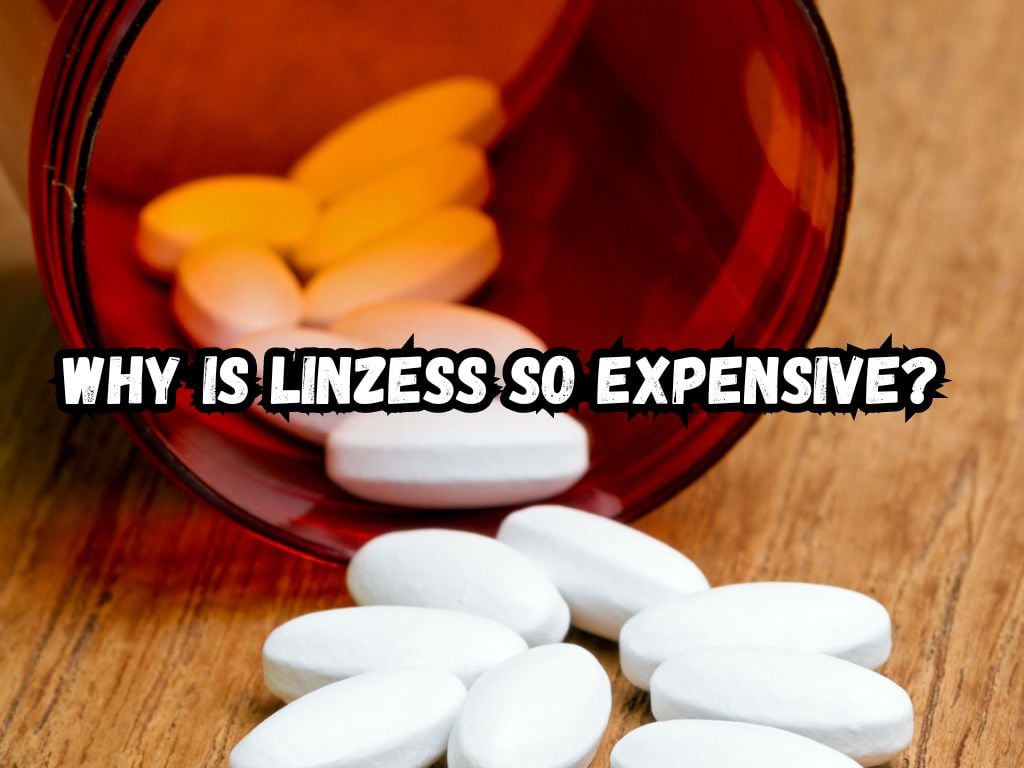Linzess is a prescription medication commonly used to treat irritable bowel syndrome with constipation (IBS-C) and chronic idiopathic constipation (CIC).
While Linzess has shown to be effective in managing these conditions, many patients are left wondering why is Linzess so expensive.
In this article, we will unveil the reasons behind the high cost of Linzess and explore potential solutions for managing the expenses.
Why is Linzess So Expensive? Factors Influencing the Cost of Linzess
Brand-name vs. Generic Drugs
One of the primary factors contributing to Linzess’ high cost is that it is a brand-name medication, not yet available in the form of generic alternatives.
Generic drugs are typically cheaper because their manufacturers don’t have the research and development (R&D) costs, marketing expenses, or patent protection expenses associated with brand-name drugs.

Research and Development (R&D) Expenses
The process of developing a new medication involves significant investments in research and clinical trials.
Pharmaceutical companies invest millions, sometimes billions, of dollars in R&D to ensure the safety and efficacy of the medication. These expenses are factored into the pricing of the drug.
Marketing and Advertising Costs
To introduce a new medication to the market, pharmaceutical companies invest heavily in marketing and advertising campaigns.
These costs include direct-to-consumer advertising, promotional materials, and salesforce expenses. These expenses contribute to the overall cost of the medication.
Patent Protection and Exclusivity
Pharmaceutical companies secure patents to protect their investment in developing new drugs. This exclusivity grants them the sole right to manufacture and sell the medication for a specific period, typically 20 years.
During this time, other companies are prevented from producing generic versions. The absence of generic competition allows brand-name drugs like Linzess to maintain high prices.
Manufacturing Costs and Complexities
The manufacturing process for medications involves strict quality control measures, specialized equipment, and adherence to regulatory guidelines.
These factors contribute to the manufacturing costs of medications, including Linzess. These costs, in turn, influence the final price of the medication for the end consumer.
Insurance Coverage and Copayments
Insurance plays a crucial role in determining the out-of-pocket cost of Linzess for patients. Insurance coverage varies depending on the provider and policy.
Some insurance plans cover Linzess, but patients may still have copayments, deductibles, and other out-of-pocket expenses. It is essential to review your insurance policy to understand the specific coverage and associated costs for Linzess.
Navigating insurance coverage can be challenging, but there are a few tips to keep in mind. First, consult your insurance provider to understand the terms and conditions of coverage regarding Linzess.
Second, consider talking to your healthcare provider about lower-cost alternatives and therapeutic equivalents. Remember to always consult with your healthcare provider before making any changes to your medication regimen.
Prescription Assistance Programs and Savings Cards
Pharmaceutical companies often offer prescription assistance programs and savings cards to help patients manage the expenses of their medications. These programs aim to reduce the financial burden by providing discounts or even free medication to eligible patients.
For Linzess, there are several savings options available, such as patient assistance programs and savings cards. These programs have specific eligibility criteria and offer varying benefits.
To access these savings cards and discount programs, you can visit the Linzess manufacturer’s website or inquire with your healthcare provider about available assistance programs. They can provide valuable information and guide you through the application process, ensuring you receive the maximum benefits available.
Alternative Medications and Therapies
While Linzess may be an effective medication for managing IBS-C and CIC, there are alternative treatment options available.
Discussing alternative medications or therapies with your healthcare provider can help explore cost-effective solutions for your condition. They can provide insights into other medications or lifestyle changes that may help alleviate symptoms without breaking the bank.

Potential Legislative and Policy Solutions
Addressing the issue of expensive medications like Linzess at a systemic level requires policies and legislative changes to make healthcare more affordable.
Government policies have the potential to influence prescription drug pricing, increase transparency, and encourage competition.
Advocacy efforts are underway to push for changes that can alleviate the financial burden on patients. It is essential to stay informed about such developments and support initiatives that aim to make medications more accessible and affordable.
Frequently Asked Questions
How much does Linzess cost without insurance?
The cost of Linzess without insurance can be high, averaging around $490 per month. However, prices may vary based on factors such as pharmacy location and dosage.
Is Linzess covered by Medicare?
Linzess is typically covered by Medicare Prescription Drug Plans (Part D) and Medicare Advantage plans that include prescription drug coverage. However, patients may still have copayments or other out-of-pocket expenses.
Are there generic alternatives to Linzess?
Currently, there are no generic alternatives to Linzess available on the market due to patent protection. However, it is possible for generic versions to become available once the patent expires.
How can I lower the cost of Linzess?
To lower the cost of Linzess, explore prescription assistance programs, savings cards, and discuss with your healthcare provider the possibility of alternative medications or therapies that are more affordable.
What other options are available for treating my condition?
There are alternative medications and therapies available for the treatment of IBS-C and CIC. Discuss with your healthcare provider to explore other options that may be more cost-effective while still addressing your condition effectively.
Conclusion
The high cost of Linzess can be attributed to various factors, including brand-name pricing, R&D expenses, marketing costs, patent protection, and complex manufacturing processes. The lack of generic alternatives further contributes to the high pricing.
However, there are potential solutions to manage the cost, such as insurance coverage, prescription assistance programs, and exploring alternative treatments.
Additionally, advocacy efforts and potential legislative changes aim to make prescription medications more affordable.
By understanding these factors and exploring available options, patients can navigate the cost of Linzess more effectively and receive the treatment they need without undue financial strain.


 Tags:
Tags:










